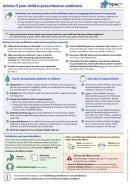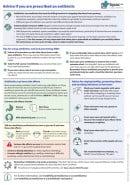Amoxicillin
Sounds like 'a-mox-ih-sil-in'
Key points about amoxicillin
- Amoxicillin is an antibiotic used to treat infections caused by bacteria.
- Amoxicillin is also called Alphamox®, Miro-Amoxicillin® or Amoxil®.
- Find out how to take it safely and possible side effects.

Amoxicillin is an antibiotic used to treat different infections caused by bacteria. Examples of infections amoxicillin may be used for include chest infections, dental infections and infections of the throat, ear and sinus.
It works by killing or stopping the growth of bacteria (bugs) and getting rid of the infection. Amoxicillin belongs to a group of antibiotics called penicillins. Like all antibiotics, it's not effective against infections caused by viruses.
Allergy to penicillin
- Before taking amoxicillin: Tell your healthcare provider if you've had an allergic reaction to a medicine, especially a penicillin antibiotic. True penicillin allergy is rare – fewer than 5 out of 10,000 people are allergic to penicillin. Most people who think they have a penicillin allergy don't – read more about penicillins and penicillin allergy.
- After taking amoxicillin: If you develop signs of an allergic reaction such as skin rash, itching, swelling of your lips, face and mouth, or difficulty breathing, stop taking amoxicillin and seek immediate medical attention.
In Aotearoa New Zealand amoxicillin is available as capsules (250 mg and 500 mg) or liquid (125 or 250 mg in 5 mL) and can be given as an injection in the hospital.
- The dose of amoxicillin will be different for different people depending on the type of infection and your age.
- The usual dose of amoxicillin capsules in adults is 500 mg or 1000 mg, 3 times a day.
- The dose for children will depend on their body weight. It may be given 2, 3 or 4 times a day.
- Your healthcare provider will advise you how long to take amoxicillin for (usually 3 to 10 days).
- For most infections, you should feel better within a few days.
- Always take your amoxicillin exactly as your healthcare provider has told you. The pharmacy label on your medicine will tell you how much to take, how often to take it and any special instructions.
- Capsules: Swallow the capsules with a drink of water. Don't chew them.
- Liquid amoxicillin: Shake the bottle well and use an oral syringe or measuring spoon to carefully measure each dose.
- Timing of your doses: Try to space the doses evenly throughout the day. If you take it 3 times a day, this could be first thing in the morning, mid-afternoon and at bedtime. Ideally these times should be at least 4 hours apart.
- Food: You can take amoxicillin capsules with or without food.
- Missed dose: If you forget to take your dose, take it as soon as you remember. But if it's nearly time for your next dose, take the next dose at the right time. Don't take extra doses to make up for a forgotten dose. If you're not sure what to do, ask your healthcare provider.
- Finish the course: Take the whole course of antibiotics for the number of days your healthcare provider has told you to. Don't stop taking it, even if you feel your infection has cleared up. If you stop your treatment early, your infection could come back.
For information on how to give amoxicillin to children, see amoxicillin information for parents and carers.(external link)
Here are some things to know when you're taking amoxicillin. Other things may be important as well, so ask your healthcare provider what you should know about.
- Amoxicillin liquid: Store your amoxicillin liquid in the fridge and discard any remaining liquid after your course is finished. You can return any unused medicine to your pharmacy.
- Alcohol: Amoxicillin doesn't directly interact with alcohol. This means that most people could have the occasional drink while taking it without any serious problems. However, if amoxicillin makes you feel sick (nauseous), don't drink alcohol as it will make you feel worse.
- If you're taking the contraceptive pill, you don't need to use additional contraception if you're taking amoxicillin. But if you have diarrhoea (runny poo) or vomiting (being sick) that lasts more than 24 hours, absorption of the contraceptive pill may be affected. If you have diarrhoea or vomiting, ask your healthcare provider for advice.
Like all medicines, amoxicillin can cause side effects, although not everyone gets them. Often side effects improve as your body gets used to the new medicine.
Other side effects
| Side effects | What should I do? |
|
|
|
|
|
|
|
|
|
|
For more information on side effects, see the Medsafe consumer information leaflets below.
Read more about medicines and side effects and reporting a reaction you think might be a side effect.
The following links have more information on amoxicillin.
Amoxicillin for adults(external link) NZ Formulary te reo Māori(external link)
Amoxicillin for children(external link) NZ Formulary
Alphamox liquid(external link) Medsafe Consumer Information, NZ
Miro-Amoxicillin capsules(external link) Medsafe Consumer Information, NZ
Brochures
Advice if you are prescribed an antibiotic(external link) BPAC, NZ, 2024
Advice if your child is prescribed an antibiotic(external link) BPAC, NZ, 2024
Medicines and side effects(external link) Healthify He Puna Waiora, NZ, 2024
Apps/tools
Amoxicillin paediatric dose calculator
References
- Amoxicillin(external link) NZ Formulary, NZ
- Antibiotics – choices for common infections(external link) BPAC, NZ, 2021
- Recommended regimens for Helicobacter pylori eradication in adults(external link) NZ Formulary, NZ
- Primary care antibiotic guide(external link) BPAC, NZ, 2024
- When is an allergy to an antibiotic really an allergy?(external link) BPAC, NZ, 2015
Brochures

Advice if your child is prescribed an antibiotic
BPAC, NZ, 2024

Medicines and side effects
Healthify He Puna Waiora, NZ, 2024
Credits: Healthify editorial team. Healthify is brought to you by Health Navigator Charitable Trust.
Reviewed by: Stephanie Yee, Pharmacist, Auckland.
Last reviewed:






